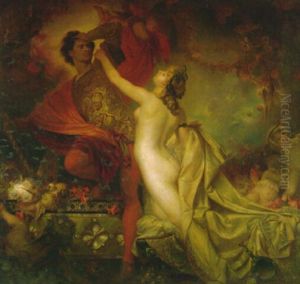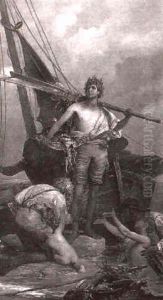Arthur Heinrich Wilhelm Fitger Paintings
Arthur Heinrich Wilhelm Fitger was a multifaceted German artist, born in 1840 in Bremerhaven, and passed away in 1909 in Bremen. His contributions to the world of art spanned painting, illustration, and writing, making him a versatile figure in the late 19th and early 20th centuries. Fitger was deeply influenced by the Romantic and Symbolist movements, which is evident in his thematic choices and stylistic expressions.
Fitger embarked on his artistic journey at the Düsseldorf Art Academy, where he was mentored by the likes of Oswald Achenbach and Eduard Bendemann. These early influences helped shape his initial artistic direction, which was characterized by a focus on historical and mythological subjects. However, as his career progressed, Fitger's work evolved to incorporate more contemporary themes and demonstrate a keen interest in the Symbolist movement, which sought to express the idea that reality could be accessed through the symbols and myths embedded in human consciousness.
In addition to his paintings, Fitger was known for his decorative works and murals, some of which adorned public buildings in Germany. His ability to blend aesthetic appeal with profound symbolic meaning made these works stand out. Furthermore, Fitger's talent extended to the literary realm; he wrote essays and critiques on art, contributing to the cultural discourse of his time. His writings not only shed light on his own artistic philosophies but also offered insights into the broader trends and movements within the European art world.
Arthur Heinrich Wilhelm Fitger's legacy is that of a bridge between the traditional and the modern. Through his diverse body of work, he captured the transition of art from the romantic idealism of the 19th century to the more introspective and symbolic approaches of the early 20th century. Despite facing criticism from some contemporaries for his eclectic style and approach, Fitger remained committed to his vision, leaving behind a rich portfolio that continues to be studied and appreciated for its depth and beauty.





